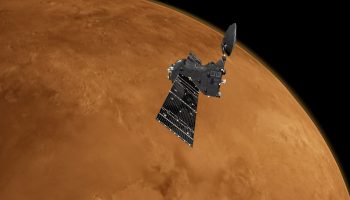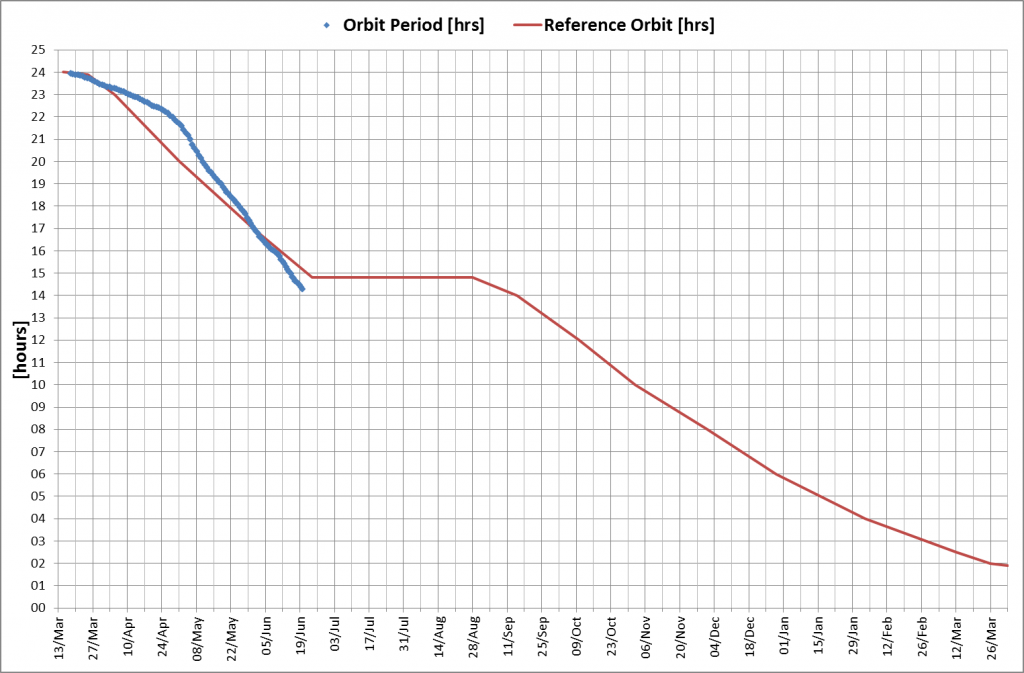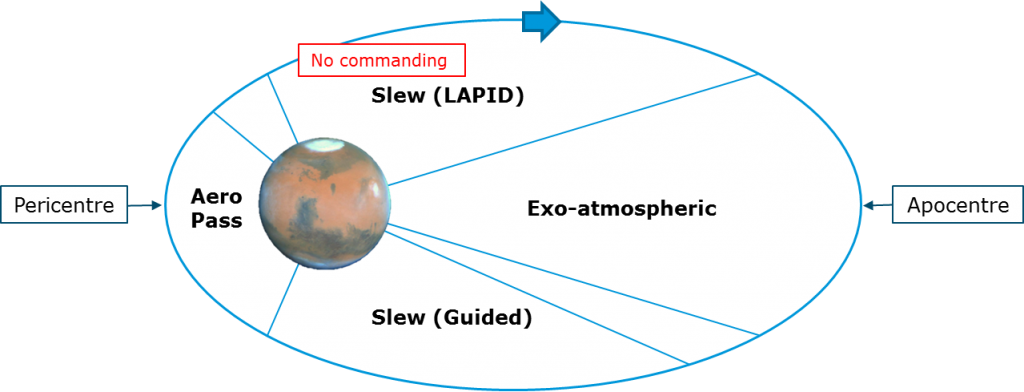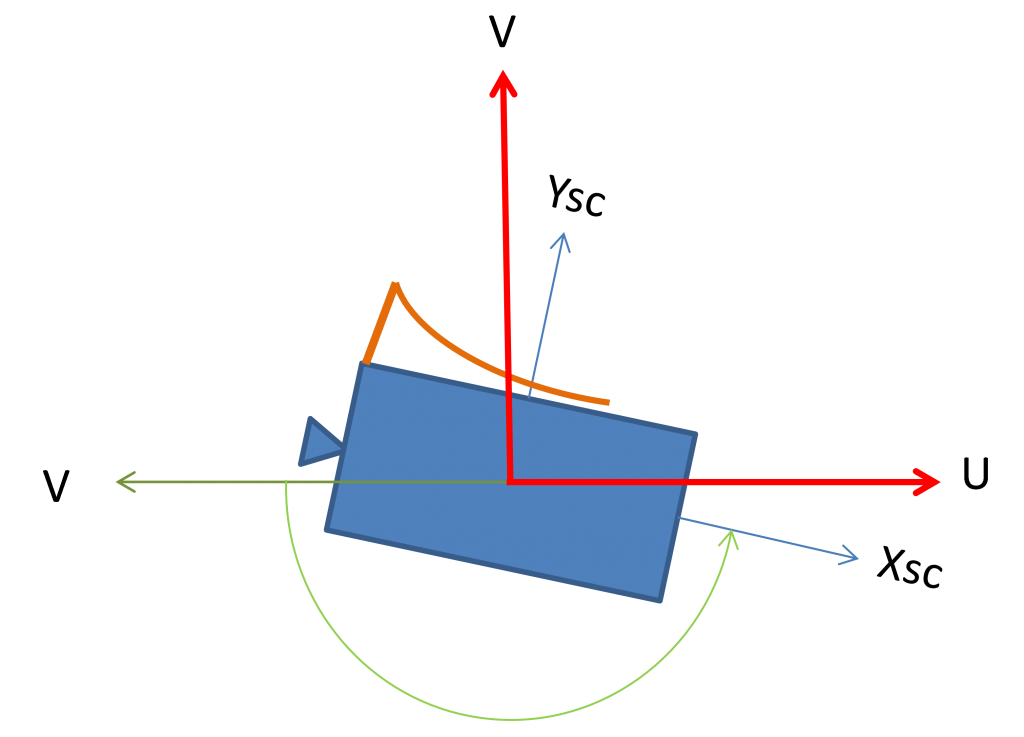On 25 June, the Trace Gas Orbiter (TGO) will suspend its aerobraking campaign until the end of August due to Mars’ conjunction with the Sun.

Trace Gas Orbiter at Mars Credit: ESA/ATG medialab
With Mars behind the Sun, TGO’s communication with Earth will be difficult, and so the spacecraft orbit will be raised safely out of the atmosphere. The orbiter is now on an aerobraking campaign, exploiting the resistance of the Martian atmosphere on the spacecraft to slow itself down and lower its orbit with minimal fuel consumption.
What’s aerobraking? To lower its altitude, the spacecraft is using the drag of the Martian atmosphere. This technique is called aerobraking and involves incrementally lowering the highest point of its elliptical orbit (apocentre; apoares) by flying the craft through the uppermost regions of the atmosphere when at the lowest point of the orbit (pericentre; periares).
While aerobraking, TGO orbits through the atmosphere in a particular attitude for reasons of thermal and aerodynamic stability. The orbit is being continually tuned by the flight dynamics team at ESOC to maximise braking without exceeding the spacecraft’s thermal limits. The Martian atmosphere is highly variable and this variability makes it impossible to plan ahead for more than a handful of orbits; so, during the conjunction period, the spacecraft is being taken out of aerobraking and placed into a safe orbit where the atmosphere won’t disturb it. TGO’s descent will resume after the end of conjunction.
Changing orbit, changing operations
TGO needs to come closer to Mars’ surface to reach its science orbit. It’s main science goal is to make a detailed inventory of gases in the planet’s atmosphere, with a particular emphasis on searching for signatures related to active geological or biological processes. It will monitor seasonal changes in atmospheric composition and temperature in order to create and refine detailed atmospheric models.
Upon arrival at Mars on 19 October last year, the TGO orbit was 33,000 x 205 km, the goal of the approximately 11-month-long aerobraking campaign is to bring this to a 370 x 420 km quasi-circular orbit.
From March to June this year, the orbit duration was reduced from 24 to approximately 14 hours using this aerobraking technique. The target is to reach an orbit that lasts about two hours for the science phase of the mission. As the orbit duration is gradually reduced, the more frequent orbits will require constant communication with the spacecraft – from January 2018 on, deep space antennas from ESA Estrack and NASA DSN will connect to TGO, 24 hours a day, 7 days a week.
“This has important repercussions on our operations procedures,” explains Peter Schmitz, ESA’s ExoMars Spacecraft Operations Manager.
“Now, the team receive data and send commands to perform aerobraking around once a day; later, during the final phase of the descent, they will have around 12 orbits a day, and will need to send many more telecommands.”
Later, the ExoMars mission control team at ESOC in Darmstadt, Germany, will use a TGO ‘test bench’ (basically, an engineering copy of the spacecraft) located at the spacecraft’s manufacturer, Thales Alenia Space (Italy) in Turin, to test the new procedures, getting ready for the final, intense, phase of operations.
During the early months of TGO operations at Mars, the ExoMars operations team have kept a close eye on any possible sources of risk as the craft gets closer to the surface. It is crucial that all spacecraft systems function correctly, especially the on-board clock and the solar array.
“Any imprecision in calculations or an unexpected reset could result in an automatic ‘pop-up’ manoeuvre, taking us out of aerobraking altogether and delaying the start of the science and relay phase,” says Spacecraft Operations Engineer Chris White.

The figure above shows the planned evolution of the orbital period (red curve) and the actual, measured evolution of the orbital period (blue), as a function of time. The x-axis shows the days between March 2017 and March 2018 and the y-axis shows the orbital period in hours. Credit: ESA
In May, TGO was a little behind with its descent plan because of this ‘safety first’ approach. This cautious tactic has helped the team to understand more accurately any possible failures and evolve ways to successfully avoid them. Since this slower beginning (aerobraking began in full in March), the approach has gradually been made more aggressive, and as a result the craft has caught up to the original plan, and is now slightly ahead of schedule.
Mars’ atmosphere influence on TGO orbit
A typical ExoMars aerobraking orbit is divided into four phases.
First, in the ‘Exo-atmospheric’ phase, the spacecraft is around apocentre; it downlinks its data starting from the last known communication, including what acceleration (well, deceleration) it experienced as it orbited through the atmosphere. During this phase, the flight dynamics team at ESOC uses the radio signal to determine the current TGO orbit.

4 phases Aerobraking, ExoMars. Credit: ESA
Second, during ‘Guided Slew’, as TGO heads toward the atmosphere, it changes its attitude to ‘aerobraking attitude’. This attitude places the more heat-resistant ‘-X’ face of the spacecraft towards the oncoming atmosphere, but also makes any communication with ground impossible.
Third, the ‘Aeropass’: this is a delicate phase in which the satellite relies on on-board sensors to measure the Martian atmospheric thickness and temperature and safely navigate through it. This mode uses the satellite’s thrusters to stabilize the spacecraft.

TGO Aerobraking, satellite attitude. Credit: ESA
Lastly, the attitude changes again when TGO enters the ‘Large Angle Proportional Integral Derivative Slew’ (LAPID), re-orienting itself back to the Exo-atmospheric attitude. During LAPID, the spacecraft positions itself to point toward Earth to communicate.
If anything goes wrong during aerobraking, TGO is programmed to perform either a flux reduction or a pop-up manoeuvre.
A flux reduction is activated to accelerate the satellite at apocentre to raise the orbit when it reaches the pericentre and avoid possible threats like dust storms or any other atmospheric anomaly. The spacecraft is programmed to perform a flux reduction up to 3 times; after that, if it is still not on a safe orbit, a pop-up manoeuvre will take place.
This manoeuvre works similar to the flux reduction, however it will raise the TGO orbit completely out of the atmosphere, bringing it to a safer orbit and placing the spacecraft in safe mode.
After waking up from its short summer conjunction break, the TGO software must be updated (based on glitches found during the start of aerobraking). The software update will take at least two weeks and will consist of uploading the patch, switching the satellite into safe mode and then verifying the correct installation and implementation. Following this, then the spacecraft will resume aerobraking; it is expected to begin its full science mission in early 2018.

Discussion: no comments